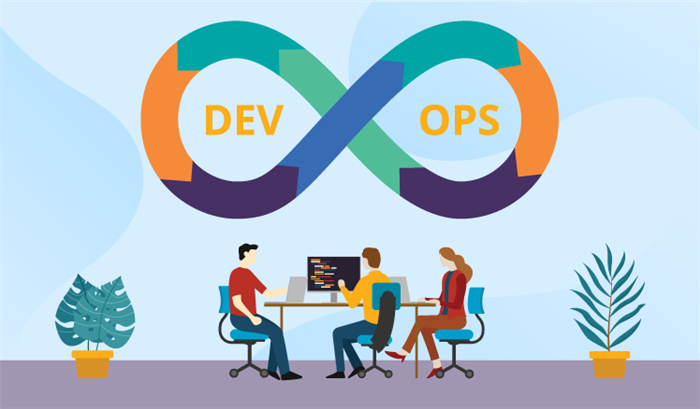
The world of information technology is constantly advancing. Technology tools, trends, and usage behaviors keep evolving with time. One of today’s leading trends that most IT companies are adopting is the integration of DevOps within development infrastructure.
In layman’s terms, DevOps refers to the integration of the services provided by development and operations teams. It takes a closer look at all the processes and workflows within an organization. From design to production support, both teams come together to synchronize their functions to meet enterprise requirements.
There are several benefits of DevOps for businesses across industries. They enable small, interdisciplinary, and autonomous teams to work together towards common business goals. Through collective efforts, fast responses, rapid inputs, and business automation, businesses are equipped to focus on faster deliveries and improved product quality.
The objective of DevOps is to reduce obstacles on the road to team collaboration and the removal of manual communication, processing delays, and inefficient automation.
To create a DevOps-oriented enterprise culture, every team needs to redefine its roles, take productive steps towards minimizing problems that arise in the workplace, and review ongoing enterprise structures and successes.
Benefits of DevOps in an Organisation:
1. It places focus on customers:
One of the main reasons enterprises are shifting to DevOps is that it helps the team understand the customer’s mindset. In a software development-focused team, developers often misunderstand their end goal. They start thinking that a great software solution is what they should work on. This mindset helps them justify longer periods for development and extended timelines since the end product is aesthetically pleasing.
Such an approach fails for two reasons. Firstly, a longer timeline is not a guarantee for a better software solution. But secondly, and more importantly, focusing too hard on the software solution makes you overlook the customer and their needs. A customer wants a functional product or solution that will solve their problems. Even the best-looking app is useless if it doesn’t fulfill its task. A DevOps organization puts developers in the mindset of the customer to ensure immediate feedback and a more functional end product.
Also Read: Devops Engineer Job Description, Roles and Responsibilities
2. DevOps brings teams together for faster shipment of products:
LIke operations teams, other teams in an organization also benefit from iterative or agile business environments. Development teams have invested significantly in agile development and turned around solutions much faster in the last ten years. But since this process took place in isolation, development teams left operations teams behind. The latter could not release solutions at the same pace as they were developed.
Using DevOps unites both teams to ensure software shipment is faster. While faster timelines are of utmost importance, the quality of the final output matters more. If you can deliver solutions fast while maintaining your output quality, it gives you an advantage over the competition.
3. It simplifies the focus of development:
Enterprises use one of two methods to develop solutions for a faster release. One is to go for a greater release where several features get packaged into a single deployment. The other method is to choose a quick release that rolls out features as and when they are ready. If you choose the former, you need to worry about prioritizing a list of features needed for that release. Generally, once you’ve started, there’s not much you can change.
meanwhile, if you download the work you put in at one point, you can significantly simplify your priorities and timelines. every week or day, your team can address a single feature, integrating development and release in an organized system. if there are any flaws or setbacks, you only need to relook at one thing as opposed to a big release where several issues must be relooked at whenever there’s a flaw.
4. It adds automation to the process of development:
Technologists and developers don’t usually put too much time towards system automation which can ultimately benefit them. Teams that generally go for big releases only don’t need automation. New deployments take place only a couple of times a year, so automation is not so important. On the other hand, smaller and faster releases take place more frequently. They can save a significant amount of time with a smooth deployment process that is automated to a great extent.
Once you know where to start, it becomes easy to implement and benefit from automation. However, businesses must ensure that automation is not being implemented for the sake of having new technology. You need to understand which process you are automating and why, along with the benefits that come with it. Some automations are not more profitable than their manual counterparts.
5. DevOps supports end-to-end responsibilities:
By itself, DevOps involves only the developing and operational teams. However, using a DevOps business model will positively impact other domains in your business as well. It also includes every individual involved in the process of delivering a solution to the end consumer.
Before developing a software solution, you need to set specifications and match customer expectations. Once the solution is developed and deployed for public use, you must find a way for consumers to communicate validation and feedback. Taking this iterative approach to software development benefits almost everyone within an organization and not just the developers.
You May Also Like: Top DevOps Interview Questions You Must Prepare
Factors Impacting the Successful Implementation of DevOps Within an Organisation:
1. Continuous and integrated operations:
It is the leading factor impacting successful DevOps implementation. It encompasses collecting any changes in the software code and putting each of these changes together through automated and systematic test phases. As opposed to the traditional way, this process allows flaw detection and helps to take corrective action in advance. As a result, you get quality assurance for your final product before its release.
2. Constant delivery:
Any new changes get delivered to the production phase for general testing. Post that, the deployed solution is put through the standard testing process.
3. Constant and consistent communication among each team:
This factor includes the break-down of segregated and single services to connect them to work together as several independent services.
4. Less manual infrastructure management:
The traditional method of infrastructure management is in the past now. The new DevOps method ensures proper infrastructure management and usage through code.
5. Code for policy management:
Codification is replacing manual infrastructure and configuration management. It is making it easier to carry out reconfiguration and flaw identification. Thus, it increases efficiency and saves time.
6. Configuration management:
A DevOps model eliminates tedious and manual host configuration management. Both configuration and operations can be managed better through code.
If you have understood each function of DevOps which describes the benefits of automation, you know how far you can go in a DevOps career. Take the first step and enroll in a training course on Koenig today.



.pngM.jpg)

.pngM.jpg)

COMMENT